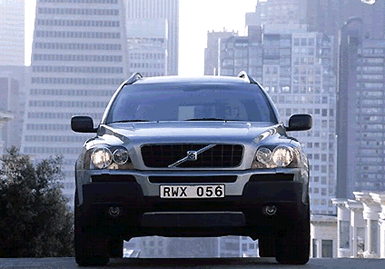|
|

San Francisco: Ever since Volvo introduced the first three-point seatbelts in1959, this
Swedish automaker has been an industry leader when it comes to safety. Therefore, when
Volvo developed its first SUV, the XC90, safety was high on the priority list. However,
Volvo showed that very safe vehicles don't have to be dull and boring.
For starters, there is an industry-first Roll Safety
Control (RSC) system to reduce the chances of a rollover. The RSC system uses gyroscopic
sensors to monitor the XC90's roll angle and roll velocity. If a possible rollover
condition is sensed, the XC90's Dynamic Stability and Traction Control (DTSC) system
reduces engine power and applies brake until the SUV is stable again.
Should the RSC not prevent a rollover, the high-strength,
boron-steel-reinforced roof protects occupants. There is also a reinforced steel cage
around the passenger compartment. The XC90 has inflatable side curtain airbags for all
three rows seats, another first. Pyrotechnic seat belt tensioners on all seats retain
occupants in place so the front and side airbags can do their job.
The XC90 features crumple zones help absorb energy during a
collision, even rear-end ones. Volvo's Whiplash Protection System reduces injuries when
hit from the rear. The XC90 even looks out for other drivers since the low front chassis
crossmember is about the same height as the bumper of an ordinary sedan. Finally, there
are daytime running lights, anti-lock brakes and large, high taillights to assure being
seen under all lighting and weather conditions.
The XC90, marketed against other luxury SUV like the Acura
MDX, BMW X5, Mercedes-Benz M-Class and Lexus RX300 comes in three versions - the
front-wheel-drive 2.5T and all-wheel-drive 2.5T AWD and T6 AWD. Two engines are available.
The 2.5T uses a 2.5-liter turbocharged in-line five-cylinder and the T6, a 2.9-liter
twin-turbocharged in-line-six. Both are mounted transversely. The T5 is rated at
208-horsepower at 5000 rpm and 236 ft-lb of torque from 1500 rpm to 4500 rpm. The T6 makes
268 horsepower at 5100 rpm and 280 ft-lb from 1800 rpm to 5000 rpm.
Both all-aluminum alloy engines feature a dual overhead
camshaft (DOHC) driven by a belt, four-valves-per-cylinder and continuously variable valve
timing (CVVT). The AWDs are driven by the front wheels, but as soon as slippage is
detected, the electronically controlled Haldex limited slip coupling transfers from 5- to
100-percent of the torque to the rear wheels depending on road conditions. Only two
transmissions are offered, an automatic five-speed transmission with Geartronic clutchless
manual shifting for the T5. Because the five-speed wouldn't fit under the hood of the T6,
it is mated to an automatic four-speed, also with Geartronic.
Like most full-size SUVs, the XC90 does not sip gasoline. The
EPA ratings for the 2.5T are 18 mpg city/24 mpg highway and for the T6, 15 mpg city/20 mpg
highway. The fuel tank holds 19 gallons and the XC90 can tow 5000 pounds when properly
equipped.
Like Volvo wagons, the interior is both cavernous and
versatile. According to Volvo, the seats can be arranged in over 64 configurations. For
example, the second- and optional third-row seatbacks fold flat. The front passenger
seatback folds down so there are nine-and-a-half feet of unobstructed space for very long
items. The second-row seats are split 40/20/40 and slide forward independently and
headrests do not have to be removed when seats are folded down. With the forward-facing
third-row seat installed, the XC90 can carry up to seven. An optional center-child-seat
booster slides forward, placing it closer to the front passenger seat. The tailgate
features a 70/30 top/bottom split so the lower edge of the liftgate is waist high. Unless
you are loading a light object, you probably will have to open both sections.
On the road, the XC90 shows it unit-body, passenger car
heritage. It is based on Volvo's largest car platform, the S80. Therefore, the XC90 rides
more like a luxury sedan than many of its truck-based SUV competition. And while not a
sports sedan, it handles, steers and brakes like a very good family station wagon;
remember that it can carry up to seven. It was especially adept at smoothing out parking
lot speed bumps. While most XC-90s will never see much off-road duty, it is quite capable
since it is a SUV not a station wagon posing as an SUV. The tight turning radius is
appreciated in both city traffic and off-road. About the only compliant is a bit of turbo
lag when accelerating.
Climbing behind the comfortable and very supportive driver
seat, you find an expansive dashboard. Though easy to read, instrumentation is limited to
speedometer, tachometer and gauges for fuel and coolant temperature. Controls for the
audio and climate control systems are very user-friendly, but the display is hard to read
under some daylight conditions.
Prices for the XC90 start at $35,125 for the 2.5T FWD,
$38.875 for the 2.5T AWD and $41,250 for the T6. Even the lowest priced XC90 comes well
equipped. However, there is a long list of options including an onboard navigation system
($1895), reverse warning system ($400), child booster seat ($400), Dolby Pro Logic II
Surround Sound System ($750), Xenon headlamps ($300), vertical cargo net ($300), wood
steering wheel ($300), and rear audio controls with headphones ($100). By Bill Siuru
& Andrea Stewart © AutoWire.Net - San Francisco

Volvo Home Page
Byline: Syndicated content provided by Tony Leopardo ©
AutoWire.Net
Column Name: Safe vehicles don't hav to be dull and boring
Topic: 2004 Volvo XC90
Word Count: 940
Photo Caption: 2004 Volvo XC90
Photo Credits: Volvo Internet Media
Series #: 2003 - 46
Download the Microsoft Word version here: 2004 Volvo XC90
Download the original image file here: 2003 Volvo XC90 62k


|
